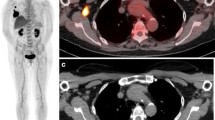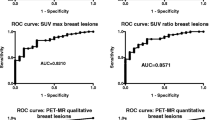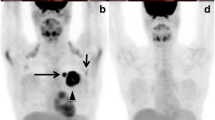Abstract
During the past decade, the application of positron emission tomography with [18F]fluoro-2-deoxy-d-glucose (FDG-PET) has remarkably improved the management of cancer patients. Nevertheless, the clinical interpretation of FDG-PET scan can be difficult for two main reasons: (1) anatomical localisation of FDG uptake is not easy, (2) normal physiological accumulation of FDG can be misinterpreted as a pathologic area. It has been demonstrated that the visual correlation of PET with morphological procedures, such as computed tomography or magnetic resonance imaging, can improve the accuracy of PET alone. However, the time interval between the two scans, the time employed by the operator and difficulties in co-registering imaging of the abdomen and pelvis make the co-registration of separately obtained images clinically difficult. A novel combined PET/CT system has been built that improves the capacity to correctly localise and interpret FDG uptake. To date only a few studies have been conducted on the potential role of PET/CT in the management of breast cancer patients, but the better performance of this technique compared with PET alone should also be relevant for breast cancer application. In this review, we evaluate the possible impact on breast cancer diagnosis of PET/CT compared with PET alone, with respect to disease re-staging, treatment monitoring, preoperative staging and primary diagnosis. In addition, the possible role of PET/CT for radiotherapy planning is evaluated.




Similar content being viewed by others
References
Beyer T, Townsend DW, Brun T, et al. A combined PET-CT scanner for clinical oncology. J Nucl Med 2000; 41:1364–1374.
Townsend DW. A combined PET/CT scanner: the choices. J Nucl Med 2001; 42:533–534.
Xu EZ, Mullani NA, Gould LK, Anderson WL. A segmented attenuation for PET. J Nucl Med 1991; 32:161–165.
Meikle SR, Dahlbom M, Cherry SR. Attenuation correction using count-limited transmission data in positron emission tomography. J Nucl Med 1993; 34:143–150.
Bettinardi V, Pagani E, Gilardi MC, et al. An automatic classification technique for attenuation correction in positron emission tomography. Eur J Nucl Med 1999; 26:447–458.
Vansteenkiste JF, Stroobants SG, Dupont PJ, et al. FDG-PET scan in potentially operable non-small cell lung cancer: do anatometabolic PET-CT fusion images improve the localisation of regional lymph node metastasis? The Leuven Lung Cancer Group. Eur J Nucl Med 1998; 25:1495–1501.
Kluetz PG, Meltzer CC, Villemagne VL, Kinahan PE, Chander S, Martinelli MA, Townsend DW. Combined PET-CT imaging in oncology: impact in patient management. Clin Positron Imag 2000; 3:223–230.
Antoch G, Stattus J, Nemat AT, Marnitz S, Beyer T, Kuehl H, Bockisch A, Debatin JF, Freudenberg LS. Non-small cell lung cancer: dual modality PET-CT in preoperative staging. Radiology 2003; 229:526–533.
Pelosi E, Messa C, Sironi S, Picchio M, Landoni C, Bettinardi V, GianolliL, Alessandro Del Maschio A, Gilardi MC, Fazio F. Value of integrated PET/CT for lesion localization in cancer patients: a comparative study. Eur J Nucl Med Mol Imaging 2004; 31:in press. DOI 10.1007/s00259-004-1483-3.
Hany TF, Steinert HC, Goerres GW, Buck A, von Schulthess GK. PET diagnostic accuracy: improvement with in-line PET-CT system: initial results. Radiology 2002; 225:575–581.
Lardinois D, Weder W, Hany TF, Kamel EM, Korom S, Seifert B, von Schulthess GK, Steinert HC. Staging of non-small-cell lung cancer with integrated positron-emission tomography and computed tomography. N Engl J Med 2003; 348:2500–2507.
Bar-Shalom R, Yefremov N, Guralnik L, Gaitini D, Frenkel A, Kuten A, Altman H, Keidar Z, Israel O. Clinical performance of PET/CT in evaluation of cancer: additional value for diagnostic imaging and patient management. J Nucl Med 2003; 44:1200–1209.
Buck A, Wahl A, Eicher U, et al. Combined morphological and functional imaging with FDG PET-CT for restaging breast cancer: impact on patient management. J Nucl Med 2003; 44:78P.
Tatsumi M, Cohade C, Mourtzikos K, Wahl R. Initial experience with FDG PET-CT in the evaluation of breast cancer. J Nucl Med 2003; 44:394P.
Czernin J. Summary of selected PET-CT abstracts from the 2003 Society of Nuclear Medicine Annual Meeting. J Nucl Med 2004; 45:102S–103S.
Giordano SH, Buzdar AU, Smith TL, Kau S-W, Yang Y, Hortobagyi GN. Is breast cancer survival improving? Trends in survival for patients with recurrent breast cancer diagnosed from 1974 through 2000. Cancer 2004; 100:44–52.
Jemal A, Murray T, Samuels A, Ghafford A, Ward E, Thun MJ. Cancer statistics. CA Cancer J Clin 2003; 53:5–26.
Biersack HJ, Palmedo H. Locally advanced breast cancer: is PET useful for monitoring primary chemotherapy? J Nucl Med 2003; 44:1815–1817.
Avril N, Rose CA, Schelling M, Dose J, Kuhn W, Bense S, Weber W, Ziegler S, Graeff H, Schwaiger M. Breast imaging positron emission tomography and fluor 18 fluorodeoxyglucose: use and limitations. J Clin Oncol 2000; 18:3495–3502.
Bombardieri E, Aktolun C, Baum RP, Bishof-Delaloye A, Buscombe J, Chatal JF, Maffioli L, Moncayo R, Mortelmans L, Reske SN. FDG-PET: procedure guidelines for tumour imaging. Eur J Nucl Med Mol Imaging 2003; 30:BP115–BP124.
Leung JWT. New modalities in breast imaging: digital mammography, positron emission tomography, and sestamibi scintimammography. Radiol Clin North Am 2002; 40:467–482.
Bombardieri E, Crippa F, Baio SM, Peeters BAM, Greco M, Pauwels EKJ. Nuclear medicine advances in breast cancer imaging. Tumori 2001; 87:277–287.
Minn H, Soini I. F-18 fluorodeoxyglucose scintigraphy in diagnosis and follow up of treatment in advanced breast cancer. Am J Clin Pathol 1989; 91:535–541.
Kubota K, Matsuzawa T, Amemiya A, et al. Imaging of breast cancer with F-18 fluorodeoxyglucose and positron emission tomography. J Comput Assist Tomogr 1989; 13:1097–1098.
Avril N, Schelling M, Dose J, Weber WA, Schwaiger M. Utility of PET in breast cancer. Clinical Positron Imaging 1999; 2:261–271.
Moore NR, Dixon AK, Wheeler TK, Freer CE, Hall LD, Sims C. Axillary fibrosis or recurrent tumour: an MRI study in breast cancer. Clin Radiol 1990; 42:42–46.
Goerres GW, Michel SC, Fehr MK, Kaim AH, Steinert HC, Seifert B, von Schulthess GK, Kubik-Huch RA. Follow-up of women with breast cancer: comparison between MRI and FDG PET. Eur Radiol 2003; 13:1635–1344.
Moon DH, Maddahi J, Siverman DH, Glaspy JA, Phelps ME, Hoh CK. Accuracy of whole-body fluorine-18-FDG PET for the detection of recurrent or metastatic breast carcinoma. J Nucl Med 1998; 16:3375–3379.
Suarez M, Perez-Castejon MJ, Jimenez A, Domper M, Ruiz G, Montz R, Carreras JL. Early diagnosis of recurrent breast cancer with FDG-PET in patients with progressive elevation of serum tumor markers. Q J Nucl Med 2002; 46:113–121.
Flamen P, Hoekstra OS, Homans F, Van Custem E, Maes A, Stroobants S, Peeters M, Penninckx F, Filez L, Bleichrodt RP, Mortelmans L. Unexplained rising carcinoembryonic antigen (CEA) in the postoperative surveillance of colorectal cancer: the utility of positron emission tomography (PET). Eur J Cancer 2001; 37:862–869.
Baum RP, Przetak C. Evaluation of therapy response in breast and ovarian cancer patients by positron emission tomography (PET). QJ Nucl Med 2001; 45:257–268.
Jansson T, Westlin JE, Ahlstrom H, Lilja A, Langstrom B, Bergh J. Positron emission tomography studies in patients with locally advanced and/or metastatic breast cancer: a method for early therapy evaluation? J Clin Oncol 1995; 13:1470–1477.
Price P, Jones T. Can positron emission tomography (PET) be used to detect subclinical response to cancer therapy? The EC PET Oncology concerted action and the EORTC PET Study Group. Eur J Cancer 1995; 31:1924–1927.
Wahl RL, Zasadny K, Helvie M, Hutchins GD, Weber B, Cody R. Metabolic monitoring of breast cancer chemohormonotherapy using positron emission tomography: initial evaluation. J Clin Oncol 1993; 11:2101–2111.
Dehdashti F, Flanagan FL, Mortimer JE, Katzenellenbogen JA, Welch MJ, Siegel BA. Positron emission tomographic assessment of “metabolic flare” to predict response of metastatic breast cancer to antiestrogen therapy. Eur J Nucl Med 1999; 26:51–56.
Tiling R, Linke R, Untch M, Richter A, Fieber S, Brinkbaumer K, Tatsch K, Hahn K.18F-FDG PET and 99mTc-sestamibi scintimammography for monitoring breast cancer response to neoadjuvant chemotherapy: a comparative study. Eur J Nucl Med 2001; 28:711–720.
Schelling M, Avril N, Nahrig J, Kuhn W, Romer W, Sattler D, Werner M, Dose J, Jenicke F, Graeff H, Schwaiger M. Positron emission tomography using [18F]fluorodeoxyglucose for monitoring primary chemotherapy in breast cancer. J Clin Oncol 2000; 18:1689–1695.
Biersack HJ, Palmedo H. Locally advanced breast cancer: is PET useful for monitoring primary chemotherapy? J Nucl Med 2003; 44:1815–1817.
Hoh CK, Hawkins RA, Glaspy JA, et al. Cancer detection with whole-body PET using [18F]fluoro-2-deoxy-d-glucose. J Comput Assist Tomogr 1993; 17:582–589.
Bender H, Kirst J, Palmedo H, et al. Value of 18fluoro-deoxyglucose positron emission tomography in the staging of recurrent breast carcinoma. Anticancer Res 1997; 17:1687–1692.
Utech CI, Young CS, Winter PF. Prospective evaluation of fluorine-18 fluorodeoxyglucose positron emission tomography in breast cancer for staging the axilla related to surgery and immunocytochemistry. Eur J Nucl Med 1996; 23:1588–1593.
Crippa F, Agresti R, Seregni E, et al. Prospective evaluation of fluorine-18-FDG PET in presurgical staging of the axilla in breast cancer. J Nucl Med 1998; 39:4–8.
Adler LP, Crowe JP, Al-Kaisi NK, Sunshine JL. Evaluation of breast masses and axillary lymph nodes with [F-18] 2deoxy-2-fluoro-d-glucose PET. Radiology 1993; 187:743–750.
Avril N, Dose J, Janicke F, et al. Assessment of axillary lymph node involvement in breast cancer patients with positron emission tomography using radiolabeled 2-(fluorine-18)-fluoro-2-deoxy-d-glucose. J Natl Cancer Inst 1996; 88:1204–1209.
Wahl RL, Siegel BA, Coleman RE, Gatsonis CG. Prospective multicenter study of axillary nodal staging by positron emission tomography in breast cancer: a report of the staging breast cancer with PET Study Group. J Clin Oncol 2004; 22:277–285.
Guller U, Nitzsche EU, Schirp U, Viehl CT, Torhorst J, Moch H, Langer I, Marti WR, Oertli D, Harder F, Zuber M. Selective axillary surgery in breast cancer patients based on positron emission tomography with18F-fluoro-2-deoxy-d-glucose: not yet! Breast Cancer Res Treat 2002; 71:171–173.
Rieber A, Schirrmeister H, Gabelmann A, Nuessle K, Reske S, Kreienberg R, Brambs HJ, Kuehn T. Pre-operative staging of invasive breast cancer with MR mammography and/or PET: boon or bunk? Br J Radiol 2002; 75:789–798.
Yap CS, Seltzer A, Schiepers C, Gambhir SS, Rao J, Phelps ME, Valk PE, Czernin J. Impact of whole-body18F-FDG PET on staging and managing patients with breast cancer: the referring physician’s perspective. J Nucl Med 2001; 42:1334–1337.
Wang Y, Yu J, Liu J, Tong Z, Sun X, Yang G. PET-CT in the diagnosis of both primary breast cancer and axillary lymph node metastasis: initial experience. Int J Radiat Oncol Biol Phys 2003; 57 (Suppl):362–363.
Eubank WB, Mankoff DA, Takasugi J, Vesselle H, Eary JF, Shanley TJ, Gralow JR, Charlop A, Ellis GK, Lindsley KL, Austin-Seymour MM, Funkhouser CP, Livingston RB. 18Fluorodeoxyglucose positron emission tomography to detect mediastinal or internal mammary metastases in breast cancer. J Clin Oncol 2001; 19:3516–3523.
Fletcher SW, Black W, Harris R. Report of international workshop on screening for breast cancer. J Natl Cancer Inst 1993; 85:1644–1656.
Tabar L, Duffy SW, Krusemo UB. Detection method, tumor size and node metastasis in breast cancer diagnosed during a trial of breast cancer screening. Eur J Cancer Clin Oncol 1987; 23:959–962.
Kopans DB. The positive predictive value of mammography. Am J Roentgenol 1992; 158:521–526.
Bird RE, Wallace TW, Yankaskas BC. Analysis of cancer missed at screening mammography. Radiology 1992; 184:613–617.
Jackson VP. The current role of ultrasonography in breast imaging. Radiol Clin North Am 1995; 33:305–311.
Stavros AT, Thickman D, Rapp CL, Dennis MA, Parker SH, Sisney GA. Solid breast nodules: use of sonography to distinguish between benign and malignant lesions. Radiology 1995; 196:123–134.
Heywang SH, Wolf A, Pruss E, Hilbertz T, Eiermann W, Permanetter W. MR imaging of the breast with Gd-DTPA: use and limitations. Radiology 1989; 171:95–103.
Friedrich M. MRI of the breast: state of the art. Eur Radiol 1998; 8:707–725.
Avril N, Dose J, Janicke F, et al. Metabolic characterization of breast tumors with positron emission tomography using F-18 fluorodeoxyglucose. J Clin Oncol 1996; 14:1848–1857.
Crowe JP Jr, Adler LP, Shenk RR, Sunshine J. Positron emission tomography and breast masses: comparison with clinical, mammographic, and pathological findings. Ann Surg Oncol 1994; 1:132–140.
Scheidhauer K, Scharl A, Pietrzyk U, et al. Qualitative [18F]FDG positron emission tomography in primary breast cancer: clinical relevance and practicability. Eur J Nucl Med 1996; 23:618–623.
Tse NY, Hoh CK, Hawkins RA, et al. The application of positron emission tomographic imaging with fluorodeoxyglucose to the evaluation of breast disease. Ann Surg 1992; 216:27–34.
Buck A, Schirrmeister H, Kuhn T, Shen C, Kalker T, Kotzerke J, Dankerl A, Glatting G, Reske S, Mattfeldt T. FDG uptake in breast cancer: correlation with biological and clinical prognostic parameters. Eur J Nucl Med Mol Imaging 2002; 29:1317–1323.
Mah K. et al. The impact of18FDG-PET on target and critical organs in CT-based treatment planning of patients with poorly defined non-small-cell lung carcinoma: a prospective study. Int J Radiat Oncol Biol Phys 2002; 52:339–350.
Giraud P, Grahek D, Montravers F, et al. CT and FDG image fusion for optimisation of conformal radiotherapy of lung cancer. Int J Radiat Oncol Biol Phys 2001; 49:1249–1257.
Dizendorf EV. Impact of whole-body18F-FDG PET on staging and managing patients for radiation therapy. J Nucl Med 2003; 44:30–32.
Erdi YE, Rosenzweig K, Erdi AK, et al. Radiotherapy treatment planning for patients with non-small-cell lung cancer using positron emission tomography (PET). Radiother Oncol 2002; 62:51–60.
Ciernik IF, Dizendorf E, Baumert BG, Reiner B, Burger C, Davis JB, Lutolf UM, Steinert HC, Von Schulthess GK. Radiation treatment planning with an integrated positron emission and computer tomography (PET/CT): a feasibility study. Int J Radiat Oncol Biol Phys 2003; 57:853–863.
Author information
Authors and Affiliations
Corresponding author
Rights and permissions
About this article
Cite this article
Zangheri, B., Messa, C., Picchio, M. et al. PET/CT and breast cancer. Eur J Nucl Med Mol Imaging 31 (Suppl 1), S135–S142 (2004). https://doi.org/10.1007/s00259-004-1536-7
Published:
Issue Date:
DOI: https://doi.org/10.1007/s00259-004-1536-7




